You’ve probably seen it on Instagram: someone stretched like a pretzel by a therapist in a quiet room with incense burning and soft music. But Thai massage isn’t just a trendy spa treat-it’s a 2,500-year-old healing system rooted in the same traditions that gave us Ayurveda and Traditional Chinese Medicine. Unlike Swedish or deep tissue massage, Thai massage doesn’t just relax muscles. It moves energy, resets joints, and reconnects body and mind using techniques passed down through generations of healers in Thailand.
What Exactly Is Thai Massage?
Thai massage, or Nuad Boran in Thai, means "ancient massage." It’s not just pressure or stretching. It’s a full-body routine that combines acupressure, assisted yoga postures, and energy line work. Practitioners use their hands, thumbs, elbows, knees, and even feet to apply rhythmic pressure along ten main energy lines called Sen lines. These lines are believed to carry life force-similar to meridians in Chinese medicine or nadis in Ayurveda.
There’s no oil. You stay fully clothed in loose, comfortable clothes. The session happens on a mat on the floor, not a table. You’re guided through stretches you couldn’t do alone-like a deep forward fold where the therapist gently presses your shoulders down while pulling your legs toward your chest. It’s intense, but not painful. Think of it as a deep stretch combined with a targeted pressure massage, all done with rhythm and intention.
Why It’s Part of Traditional Healing
Thai massage didn’t evolve in a spa. It grew out of Buddhist monasteries in northern Thailand, where monks treated illness using touch, breath, and herbal remedies. Healing wasn’t just about pain relief-it was about balance. The body was seen as a system of interconnected energy pathways. Blockages in these pathways caused pain, fatigue, or emotional distress. Thai massage was designed to clear those blockages.
Modern Thai medicine still uses this framework. Doctors in Thailand often recommend Thai massage alongside herbal compresses, cupping, or dietary adjustments. It’s not alternative-it’s integrated. In rural areas, you’ll still find village healers who learned from their grandparents, using the same techniques to treat back pain, insomnia, or digestive issues.
How Thai Massage Helps Your Body and Mind
Let’s say you sit at a desk all day. Your shoulders are tight. Your hips feel locked. Your head aches. A Swedish massage might loosen your shoulders, but Thai massage goes deeper.
- Improves flexibility: Studies show regular Thai massage increases range of motion in hips and spine more than standard stretching routines.
- Reduces chronic pain: A 2023 trial in Bangkok found participants with lower back pain reported 40% less discomfort after six weekly sessions.
- Calms the nervous system: The rhythmic pressure and breathing cues trigger the parasympathetic response-your body switches from "fight or flight" to "rest and digest."
- Boosts circulation: The compression and release motion acts like a pump, helping blood and lymph flow more freely.
- Reduces anxiety: The focused attention from the therapist, combined with slow breathing, creates a meditative state. Many people leave feeling lighter-not just physically, but mentally.
One woman from Chiang Mai told me she started Thai massage after her husband passed away. "I didn’t know how to cry," she said. "But during the session, when they pressed on my chest, I just started sobbing. It wasn’t about grief. It was like my body finally remembered how to let go."
Types of Thai Massage You’ll Find Today
Not all Thai massage is the same. Over time, styles have branched out based on region and training:
- Northern Style (Chiang Mai): More focused on deep pressure and energy lines. Slower, meditative. Often includes herbal poultices.
- Southern Style (Bangkok/Pattaya): Faster-paced, more dynamic. Emphasis on joint mobilization and athletic stretches. Popular in tourist areas.
- Traditional Wat Po Style: Taught at the famous Wat Pho temple in Bangkok. Considered the gold standard. Follows ancient texts and lineage.
- Modern Wellness Thai: Shorter sessions (30-60 minutes), adapted for office workers. Less stretching, more focused on neck, shoulders, and feet.
If you want the real thing, look for schools or centers that mention Wat Po or traditional apprenticeship. A 90-minute session with a master practitioner feels like a full reset-not just a massage.
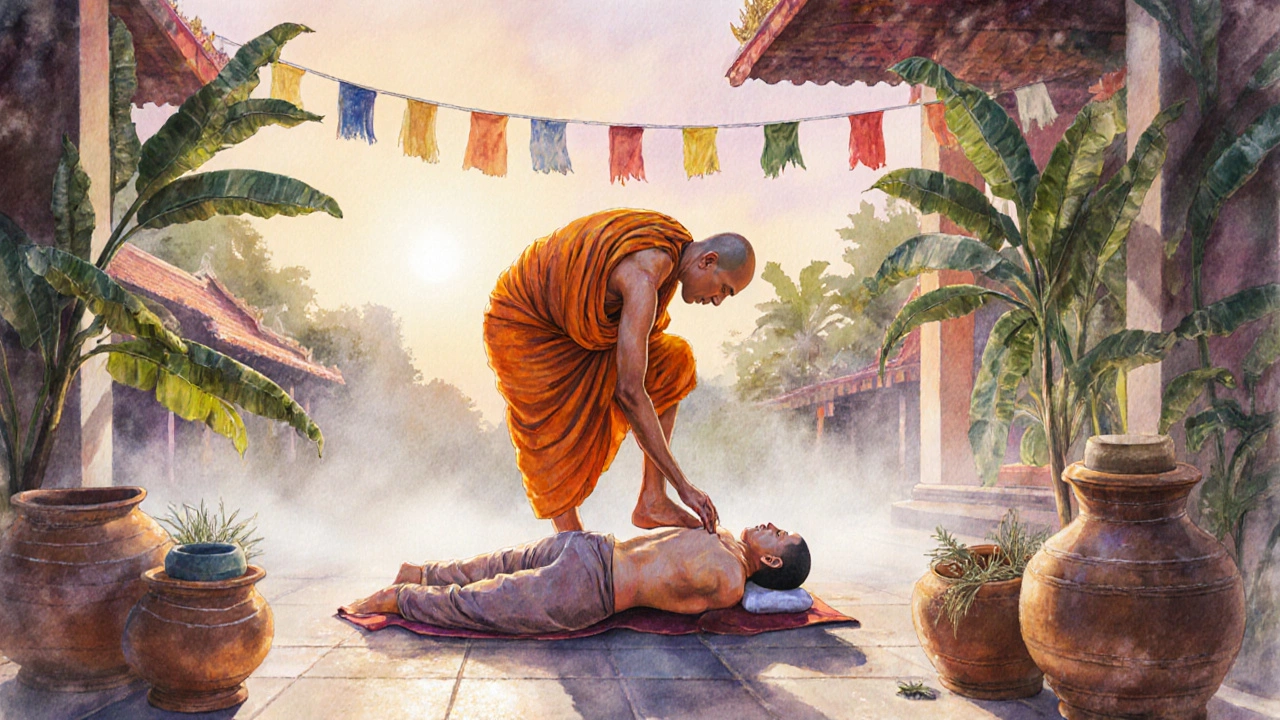
How to Find Authentic Thai Massage Services
You don’t need to fly to Thailand to experience real Thai massage. But you do need to know what to look for.
- Check if the therapist trained at Wat Pho, Chiang Mai University, or another recognized Thai institution.
- Ask if they use the term Nuad Boran-that’s the traditional name.
- Watch the space: authentic sessions happen on floor mats, not massage tables.
- They should ask about your health, not just your tension points.
- Look for reviews mentioning "energy work," "yoga-like stretches," or "felt like a reset." Avoid places that advertise "happy endings" or "sensual"-that’s not Thai massage.
In cities like New York, London, or Sydney, search for "Wat Po certified Thai massage" or "traditional Thai bodywork." Many schools now offer public classes and community sessions at lower prices.
What to Expect During Your First Session
Arrive 10 minutes early. Wear loose, stretchy clothes-yoga pants and a T-shirt work best. You’ll be asked to remove shoes and jewelry.
The therapist will begin by asking about injuries, surgeries, or conditions. Be honest. Thai massage isn’t safe for everyone-especially if you have osteoporosis, recent fractures, or are pregnant without proper training.
Then, you lie on the mat. The therapist starts at your feet and moves upward, using palms, thumbs, and elbows to press along the Sen lines. You’ll feel deep pressure, then sudden release. You’ll be guided into stretches-some awkward, some surprising. You might feel a little sore the next day. That’s normal. It’s not a limp, gentle rubdown. It’s a full-body reset.
Most sessions last 60 to 120 minutes. You won’t hear much talking. Just quiet breathing and the rhythm of movement. When it’s over, you’ll feel like you’ve slept for eight hours-but you were awake the whole time.
Pricing and Booking
Prices vary widely depending on location and expertise.
- Thailand: 300-800 THB ($8-$22 USD) for 60 minutes in a local clinic. Up to 2,500 THB ($70 USD) at Wat Po or luxury resorts.
- United States/Europe: $60-$120 for 60 minutes. $100-$180 for 90-120 minutes with a certified master.
- Community centers: Some Thai cultural centers offer sliding-scale sessions for $25-$40.
Book ahead. Good Thai massage therapists often have waiting lists. Ask if they offer a consultation before your first session-it’s a sign they care about safety, not just sales.

Safety Tips: When Thai Massage Isn’t for You
Thai massage is safe for most people-but not all.
- Avoid it if you have recent fractures, severe osteoporosis, or blood clots.
- Don’t get it if you’re pregnant unless your therapist is specifically trained in prenatal Thai massage.
- Wait at least 48 hours after surgery or chemotherapy.
- Speak up if something hurts. Deep pressure is normal. Sharp pain is not.
- Hydrate after your session. Your body is releasing toxins and needs water to flush them out.
Always choose a licensed practitioner. In Thailand, they’re certified by the Ministry of Public Health. In the U.S., look for certification from the Thai Traditional Medical Society or Wat Po.
Thai Massage vs. Shiatsu: What’s the Difference?
| Feature | Thai Massage | Shiatsu |
|---|---|---|
| Origin | Thailand, Buddhist monastic tradition | Japan, based on Traditional Chinese Medicine |
| Technique | Stretching + acupressure + joint mobilization | Finger pressure on meridians only |
| Position | On floor mat, fully clothed | On mat or chair, fully clothed |
| Energy System | Sen lines (10 main pathways) | Meridians (12 main pathways) |
| Duration | 60-120 minutes | 30-60 minutes |
| Intensity | High-active movement, deep pressure | Moderate-focused pressure, minimal movement |
| Best For | Stiffness, mobility, full-body reset | Stress, mild pain, energy balancing |
Thai massage moves your body. Shiatsu stills it. One is like a guided yoga session with pressure. The other is like a quiet, focused touch on key points. Both work-but they feel completely different.
Frequently Asked Questions
Is Thai massage painful?
It can feel intense, especially if you’re tight or haven’t stretched in a while. But it shouldn’t hurt. A good therapist adjusts pressure based on your feedback. If you feel sharp pain, tell them. The goal is deep release, not discomfort.
Can Thai massage help with sciatica?
Yes. Many people with sciatica find relief because Thai massage releases tension in the hips, glutes, and lower back-the areas that often compress the sciatic nerve. It doesn’t cure the root cause, but it reduces symptoms significantly when done regularly.
How often should I get Thai massage?
For maintenance, once a month is great. If you have chronic pain or stiffness, twice a month for 2-3 months can make a big difference. After that, switch to monthly. Think of it like physical therapy for your nervous system.
Do I need to be flexible to try Thai massage?
Not at all. In fact, most people who need Thai massage the most are the least flexible. The therapist moves you gently into stretches you can’t reach on your own. You’re never forced. It’s about helping your body open up, not showing off.
Is Thai massage spiritual?
It can be, but it doesn’t have to be. The tradition has spiritual roots in Buddhism and energy work. But modern practitioners focus on physical results-mobility, pain relief, stress reduction. If you want the spiritual side, ask for a session with a healer who incorporates breathwork or chanting. If not, they’ll treat it like physical therapy.
Ready to Try It?
Thai massage isn’t just another massage. It’s a living tradition that’s helped people heal for centuries. Whether you’re dealing with chronic pain, stress, or just feeling stiff and disconnected, it offers something most treatments don’t: a full-body reset that leaves you feeling grounded, open, and calm. You don’t need to believe in energy lines to feel the difference. Just show up, breathe, and let your body move.
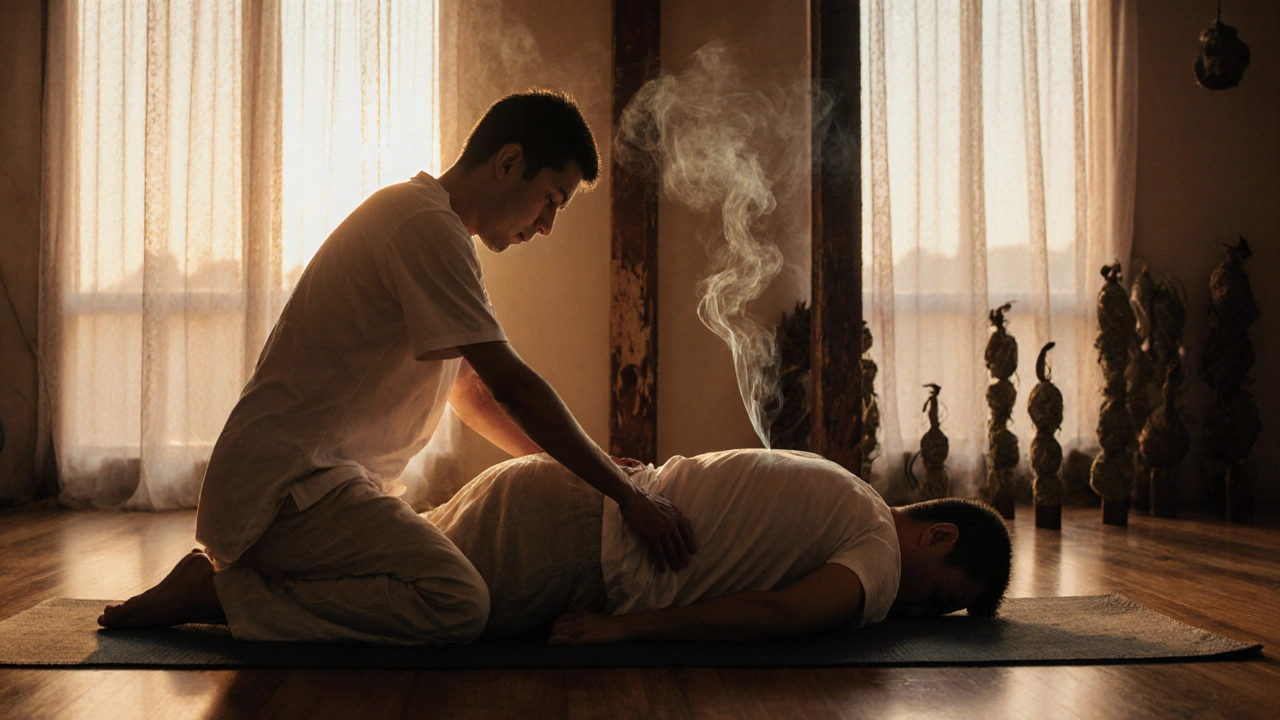

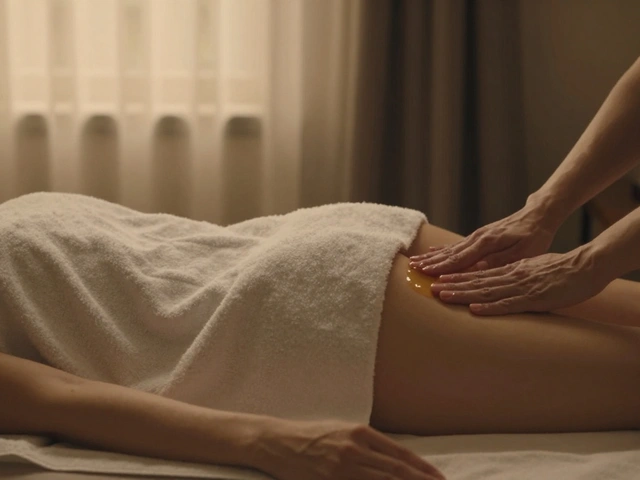
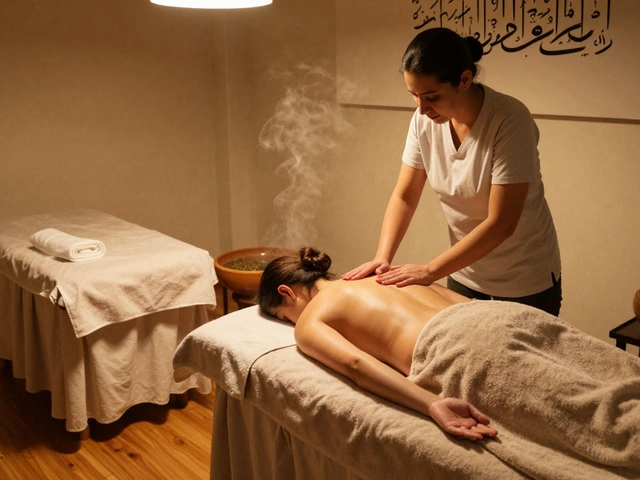
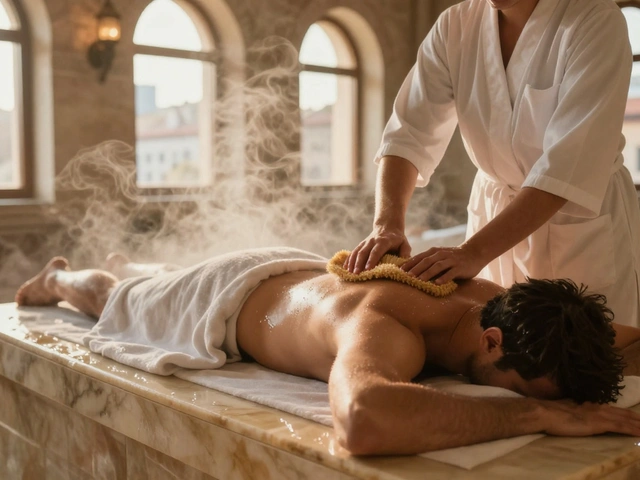
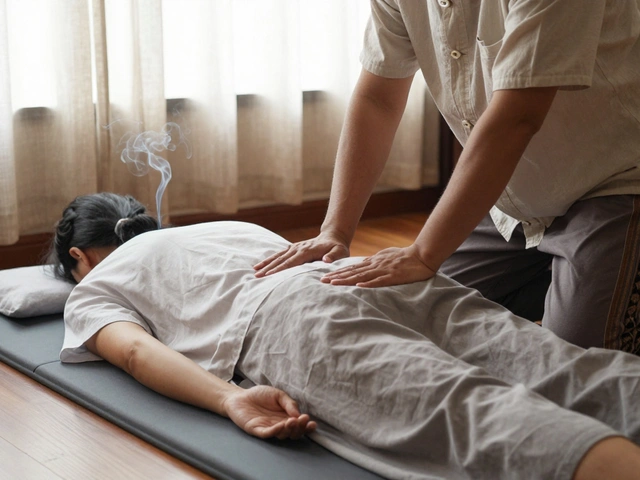
This isn't massage-it's a full-body hostage negotiation with a Thai monk who's been meditating since 1987. I went in for back pain and came out crying while they used their FOOT to press my glutes. I didn't know my body had that many secrets. Now I'm convinced my spine was just waiting for someone to yell 'BREATHE' at it.
Let’s be real-Western medicine treats symptoms like they’re bugs to squash. Thai massage? It’s a conversation with your nervous system. You’re not getting a rubdown-you’re being reprogrammed. The Sen lines aren’t metaphors; they’re biological highways your body built before capitalism invented ‘stress.’ If you think yoga is stretching, you haven’t let someone use their knee to open your hip socket. That’s not pain. That’s liberation.
Interesting, but I’m skeptical. Where’s the peer-reviewed data on Sen lines? I mean, sure, it feels nice-but is it placebo? Also, why do people always say 'I cried during it' like it’s some kind of spiritual rite of passage? 🤔
Thank you for writing this with such care. I’ve been getting Thai massage for five years now-started after my divorce-and I can confirm: it doesn’t just release muscle tension, it releases grief. The therapist at Wat Po in Chiang Mai once said, 'Your body remembers what your mind forgets.' I’ve never forgotten that. Please, if you’re feeling numb-go. Don’t overthink it. Just show up. 🙏
As someone who’s studied somatic therapies, I’d argue Thai massage is a form of neuromuscular recalibration-specifically, it modulates proprioceptive feedback loops via rhythmic compression and passive range-of-motion protocols. The Sen lines? Probably an early phenomenological mapping of fascial planes. Still, the cultural lineage is undeniable. If you're looking for embodied regulation without pharmaceuticals, this is top-tier. Also, hydrate. Always hydrate. 💧
Wait-so you’re telling me a temple in Thailand has been quietly running a global mind-control program disguised as massage? I’ve read reports. The rhythmic pressure, the chanting, the forced stretching-it’s all designed to lower your critical thinking. They’re not healing you. They’re resetting your baseline to make you more compliant. Why do you think they don’t let you wear tight clothes? It’s about control. And why are the therapists always so calm? That’s not peace-that’s conditioning. I’ve got friends who went and came back… quieter. Too quiet.
I appreciate the thoroughness of this post. However, I must respectfully correct a minor inaccuracy: the term 'Nuad Boran' is correctly transliterated with a final 'n'-not 'Nuad Boran' as written. Additionally, the distinction between Northern and Southern styles is vital, but the Wat Po lineage should be emphasized as the most authentically preserved. Thank you for highlighting safety concerns-this is essential information that is too often omitted.
How quaint. Another Westerner romanticizing ancient Eastern rituals while ignoring the fact that Thailand’s tourism industry monetizes spiritual trauma. You don’t need a 90-minute session with a 'master' to feel better. You need therapy. Or a gym membership. Or sleep. But no-let’s pay $180 to be manhandled by someone who learned from a monk who learned from a monk who learned from a monk who probably just needed rent money. 🙄
Who funded this article? The Thai Ministry of Tourism? The Wat Po Foundation? The WHO? Because I’ve seen this exact narrative pop up after every major Thai tourist boom-right after the U.S. State Department issued a travel advisory about 'unregulated healing centers.' And why are all the testimonials from women who 'cried'? Coincidence? Or are they targeting emotionally vulnerable demographics? I’ve got a spreadsheet. I’ll send it.
Thank you for this thoughtful and deeply researched exposition. It is rare to encounter a piece that honors both the empirical and the cultural dimensions of a practice without reducing it to either mysticism or marketing. The integration of Thai massage into Thailand’s national healthcare framework is a model of holistic medicine that the West would do well to study-not as a novelty, but as a legitimate system of care. I commend the author for emphasizing safety, lineage, and accessibility. This is not merely a treatment; it is an expression of a worldview that values balance, presence, and embodied wisdom. May it continue to be practiced with integrity.